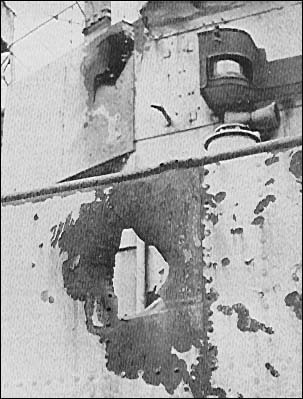In April 1949 a British warship was deliberatley attacked by Communist Forces, along the River Yantgse, China. Stranded between Nanking and Shanghai, with her commanding officer and many others dead, H.M.S Amethyst overcame the odds and fought her way to freedom in a legendary act of courage....
Above: A view of Amethyst's bridge and superstructure. In the intial attack 17 of her crew were killed, including the medical officer Surgeon Lieutenant J.M Alderton. In addition her captain, Lieutenant Commander Skinner, and another crewmember died from their injuries the following day.
. .......................
Above: (left) Lieutenant Commander Bernard Skinner was Amethyst's Commanding officer. Wounded in the initial attack and dying from his injuries a day later, he was posthumously mentioned in dispatches.(right) Lieutenant Commander Kearns received the Distinguished Service Order (DSO). He was flown out to take command of Amethyst by a RAF Sunderland together with a replacement medical officer.
Above: When Amethyst ran aground off Rose Island, 63 of her crew swam ashore, making their way by foot and then railway to Shanghai.
...............
Above: (left) damage to a gun turret (right) hammocks are used to fill a hole in Amethyst's hull.
.................

Above: (left) H.M.S Amethyst's torn white ensign was proudly flown throughout the attack.(right) A particularly large hole near Amethyst's bridge, caused by a 75mm shell.
Above: Amethyst alongside at Hong Kong: the damage to her superstructure could now be fully appreciated. Amethyst had been hit by machine gun fire as well as shelling.
Above: A picture of Amethyst reveling damage to her stern. After a period of repairs at Hong Kong, Amethyst returned to Britain arriving at Devonport in November 1950. After a refit she served in the Korean War before being placed in reserve for a number of years. In 1956 she starred in the film "Yangtse Incident" and was sold a year later for breaking up at Sutton, Plymouth.
Doug Shaw remembers Amethyst's return to Plymouth. " I was at HMS Fisgard from January 1949 until April 1950 and, during that time, spent a freezing morning on the deck of an MFV in the Hamoaze where we waited to welcome the Amethyst on her return from the China station. It was a great occasion and I remember seeing the dockyard mateys standing along the jibs of some of the huge dockside cranes that they used in those days."
Above: A total of 23 sailors were laid to rest in Shanghai, China.
Above: Simon, the ship's cat, received the Dicken Medal (the animal equivalent of the Victoria Cross), the first time the award had been granted to a cat. Although he was injured when Amethyst was shelled he nevertheless protected the ships stores from rats.
Above: H.M.S Consort had been guard ship of British Embassy at Nanking and was due to be relived by Amethyst. When news of the attack came she was rushed to Amethyst's assistance. Forced to 'run the gauntlet' down the river she too was attacked, sustaining 9 fatalities with two more crew members dying of their wounds later.
Above: London's commanding officer, Captain P.G. Cazalet. Based at Shanghai, on the mouth of the river Yangtse, London, together with the frigate Black Swan, was ordered to the aid of Amethyst.
Above: A burial at sea takes place aboard the cruiser London. London and Black Swan rendezvoused with the frigate Consort at Kiangyhn. They then continued upstream but were caught in communist fire and forced to return to Shanghai. 15 of London's crew were lost.
Above: H.M.S London alongside at Shanghai after returning from her unsuccessful bid to reach Amethyst. The 10,500 ton cruiser was an easy target for the Chinese shore batteries, as her battle damaged superstructure shows.
Above: A very smart H.M.S London arrives at Chatham dockyard upon returning from the Far East. London was a 10,500 ton London class cruiser built by Portsmouth Dockyard and launched in September 1927. She was sold for breaking up in 1950.
..........
______________________________________________________________________________________________
© Written and researched by Jeremy Olver. First uploaded 3rd September 2000. Disclaimer.